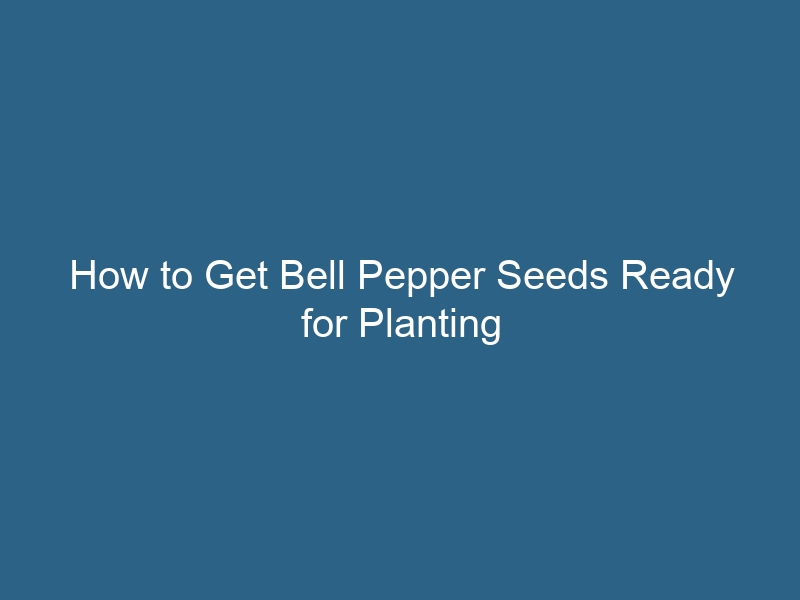Quck answer
To prepare bell pepper seeds for planting, follow these simple steps:
1. Selecting Seeds: Choose ripe and healthy bell peppers. Cut them open and remove the seeds.
2. Cleaning: Rinse the seeds under cool water to remove any remaining pulp or flesh.
3. Drying: Place the seeds on a paper towel or a fine mesh screen. Allow them to air dry for about a week or until they are completely dry.
4. Storing: Store the dried seeds in a cool, dry place in an airtight container or an envelope until you are ready to plant them.
By following these steps, you can ensure that your bell pepper seeds are properly prepared for successful planting.
Did you know that you can prepare bell pepper seeds for planting in the next year? Since the plants are capable of self-pollination, new plants will sprout from the seeds you save from this year’s harvest.
Bell peppers (Capsicum annuum) come in different colors like yellow, orange, red, green, or purple, and the seeds inside the peppers are white and disc-shaped. These small seeds need specific light and temperature conditions to germinate, and they are usually germinated indoors to control the environment. Depending on the variety and growing conditions, bell pepper seeds will take eight to 10 weeks to germinate. After germination, you can expect to harvest the peppers in 65 to 70 days.
Tip
Keep in mind that if you’re saving seeds from hybrid peppers, such as the ones you buy at the grocery store or from commercially packaged hybrid seed packs, the resulting fruits will not be similar to the pepper you took the seeds from. However, if you grow heirloom peppers, you can save the seeds from each year’s harvest to produce subsequent generations of peppers that are all the same.
Step 1: Choose the Perfect Bell Peppers
Select fresh, heirloom bell peppers from your garden to harvest the seeds. If you’re growing different types of peppers in the same area, they can cross-pollinate. This means that the resulting seeds from these cross-pollinated plants will have traits from both parent plants, and the plants (and fruits) that grow from these seeds will likely be different from the pepper you harvested. However, if you only grow one type of heirloom pepper plant, the seeds they produce will yield identical offspring plants.
Step 2: Harvest the Seeds
Using a knife, cut off the tops of the peppers. Use a spoon to scoop out the insides of the pepper. Remove any debris from the seeds and spread them out on a paper towel in a single layer.
Step 3: Dry the Seeds
Place the paper towel with the seeds on a plate. Put the seeds in a warm place away from direct sunlight. Allow the bell pepper seeds to dry for five to six days.
Step 4: Store Pepper Seeds
Store the pepper seeds in a paper envelope. Label the envelope for easy identification in the spring. Keep the envelope in a dry location until early spring arrives.
Step 5: Prepare Starting Pots
Fill seed-starting pots with seed-starting soil mix. Warm the soil to 80 degrees Fahrenheit by placing the pots under a heat lamp.
Step 6: Soak Bell Pepper Seeds
Soak the bell pepper seeds in warm water for three hours. Sow two bell pepper seeds in each container. The seeds need to be shallowly planted, so sow them at a depth twice their diameter.
Step 7: Plant the Seeds
Cover the pots with a clear plastic bag or a plastic dome that comes with seed starting pots, and keep the pots away from direct sunlight. Check the soil daily to make sure it doesn’t completely dry out. Water the soil to keep it moist, but be careful not to overwater the seeds as it can lead to fungal infestations.
Step 8: Maintain Warmth for the Seeds
It is ideal to keep the soil temperature at 80 F and provide light for 16 hours a day using a fluorescent tube or “grow light”. Make sure to turn off the light for eight hours at night and ensure that the soil temperature stays above 60 F. Repeat these heat and light conditions until the seeds start to sprout.
Step 9: Remove Excess Seedlings
Once a set of true leaves has developed, thin out the bell pepper seeds so that only one healthy seedling remains in each pot. When the danger of frost has passed and the soil temperature remains above 50 F, transplant the bell pepper seedlings outdoors. Leave a space of 12 to 18 inches between each pepper plant.


